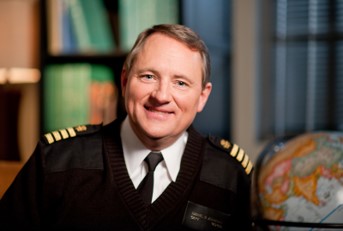Flu Fighter: Dr. Daniel Jernigan, MD, MPH (CAPT, USPHS)
Dr. Dan Jernigan, a captain in the United States Public Health Service (USPHS), serves as director of the Influenza Division in CDC’s National Center for Immunization and Respiratory Diseases. In this role, Jernigan is always working to prepare for the next influenza pandemic. “We are determined to intervene where we can to stop the spread of disease—that’s public health,” he says. For CDC’s Influenza Division, stopping the spread of disease means, “tracking influenza viruses and human illness with influenza viruses worldwide – be it from seasonal, avian, swine, or other novel flu viruses. We track illness, study the virus, assess the risk posed by the virus, make vaccine viruses that are then used to manufacture flu vaccines and help make policies for influenza prevention and treatment.”
Why the 1918 Pandemic Still Matters
Medical and technological advances made in the fight against influenza since 1918 are numerous. “First of all, we have identified that it was an influenza virus that caused the pandemic in 1918. At the time, they didn’t know that,” says Dr. Jernigan. In addition to new information about and understanding of influenza viruses themselves, we also have new medical advancements in how we treat influenza and influenza-related complications. “We have antiviral drugs that can target the virus itself. We have ventilators and intensive care units. We have vaccines. We have so much more capability now,” adds Dr. Jernigan.
Planning and Preparation are Critical; Challenges Remain
While significant advancement has been made in flu prevention, other modern developments may contribute to the impact of a pandemic today. The world is more crowded and the worlds of humans and animals continue to converge, both factors that promote the emergence of novel influenza viruses, Dr. Jernigan says. Because most influenza viruses that cause pandemics start in the animal population, improving avian and swine influenza surveillance is very important.
Everyday work in the Influenza Division centers around the study of seasonal influenza and novel influenza viruses that have pandemic potential, notes Dr. Jernigan. “Viruses are constantly changing, so that means we have to constantly monitor them. They have minor little changes that can occur throughout the year and so you have to look at them every month, even every week.” Because influenza viruses are constantly changing and the risk of pandemic influenza is imminent we must continue to expand our understanding of influenza viruses.
Being a Flu Fighter
While a lot of progress has been made in the past century, “there are still challenges and things that we can improve on,” say Jernigan. “A big challenge is vaccine — our flu vaccines take a long time to make and they have to be made to target specific viruses. Immunity from vaccination wanes over time so people need to be revaccinated annually,” Dr. Jernigan says. “We need flu vaccines that can be made more quickly, that offer longer lasting protection, and that protect against many different flu viruses. What would be wonderful would be to develop a universal vaccine that would protect against all flu viruses. But in the interim, we can make better vaccines.”
The systems that we use for seasonal influenza; virus surveillance, vaccine manufacturing, and vaccine development, are the foundation of our response to the next flu pandemic. They all need to continue improving so if we have another bad pandemic like the one in 1918, we will be much more prepared and better protected.”
Dr. Jernigan is one of many CDC flu fighters commemorating the 100th anniversary of the 1918 influenza pandemic. He emphasizes that 1918 is a reminder of the importance of preparing for future pandemics. “Influenza viruses are constantly changing, so there’s a chance a modern-day flu virus could emerge to cause a pandemic as bad as 1918,” says Dr. Jernigan. “By reflecting on the 1918 pandemic we can better understand what happened and how people and communities responded, to help inform how we might respond to a pandemic today.”



